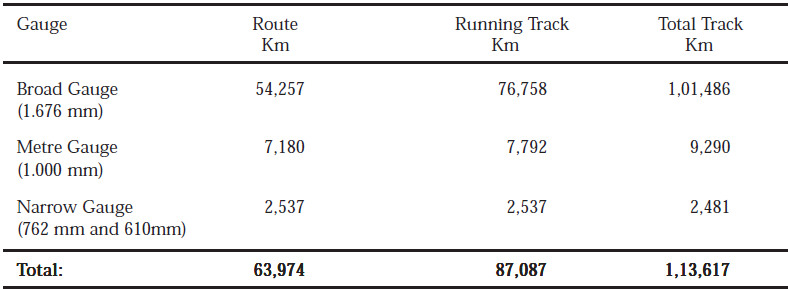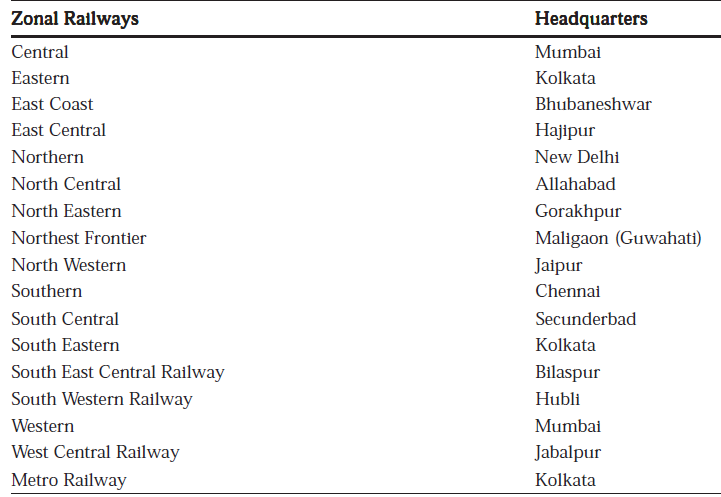Railways, India: 2 (ministry data)
(→2016: Railways bears 43% of cost) |
(→Passenger Traffic) |
||
| Line 184: | Line 184: | ||
==Passenger Traffic== | ==Passenger Traffic== | ||
| − | |||
| − | |||
Passengers originating had risen from 1,284 million in 1950-51 to 7,246 million in | Passengers originating had risen from 1,284 million in 1950-51 to 7,246 million in | ||
2009-2010 and passenger kilometre from 66.52 billion in 1950-51 to 903 billion in | 2009-2010 and passenger kilometre from 66.52 billion in 1950-51 to 903 billion in | ||
Revision as of 15:00, 12 February 2017
This article has been sourced from an authoritative, official readers who wish to update or add further details can do so on a ‘Part III’ of this article. |
Contents |
The primary source of this page
INDIA 2012
A REFERENCE ANNUAL
Compiled by
RESEARCH, REFERENCE AND TRAINING DIVISION
PUBLICATIONS DIVISION
MINISTRY OF INFORMATION AND BROADCASTING
GOVERNMENT OF INDIA
The Indian Railways' own data
The Railways in India provide the principal mode of transportation for freight and passengers. It brings together people from the farthest corners of the country and makes possible the conduct of business, sight seeing, pilgrimage and education. The Indian Railways have been a great integrating force during the last more than 155 years. It has bound the economic life of the country and helped in accelerating the development of industry and agriculture. From a very modest beginning in 1853, when the first train steamed off from Mumbai to Thane, a distance of 34 km, Indian Railways have grown into a vast network of 7,030 stations spread over a route length of 63,974 km with a fleet of 8,593 locomotives, 51,030 passenger service vehicles, 6,505 other coaching vehicles and 2,19,931 wagons as on 31st March, 2010. The growth of Indian Railways in the 150 years of its existence is thus phenomenal. It has played a vital role in the economic, industrial and social development of the country. The network runs multigauge operations extending over 63,974 route kilometres. The gauge-wise route and track lengths of the system as on 31st March, 2010 are as under:
Gauge Route Running Track Total Track
About 30 per cent of the route kilometre, 41 per cent of running track kilometre and 43 per cent of total track kilometre is electrified. The network is divided into 17 Zones. Divisions are the basic operating units. The 17 zones and their respective
headquarters are given below :
Cooperation between public and Railway administration is secured through various committees including Zonal Railway Users' Consultative Committees and Divisional Railway Users'Consultative Committees. The rolling stock fleet of Indian Railways in service as on 31st March 2009 comprised 42 Steam, 5,022 diesel and 3,825 electric locomotives. Currently, the Railways are in the process of inducting new designs of fuel-efficient locomotives of higher horse power, high-speed coaches and modern bogies for freight traffic. Modern signalling like panel inter-locking, route relay inter-locking, centralized traffic control, automatic signalling and multiaspect colour light signalling are being progressively introduced. The Indian Railways have made impressive progress regarding indigenous production of rolling stock and variety of other equipment over the years and is now self-sufficient in most of the items.
The main objectives of railways planning have been to develop the transport infrastructure to carry the projected quantum of traffic and meet the developmental needs of the economy. Since the inception of the planned era in 1950-51, Indian Railways have implemented nine five-year plans, apart from annual plans in some years. During the Plans, emphasis was laid on a comprehensive programme of system modernization. With capacity being stretched to the full, investment of costeffective technological changes become inescapable in order to meet the everincreasing demand for rail transport. Along with the major thrust directed towards rehabilitation of assets, technological changes and upgradation of standards were initiated in important areas of track, locomotives, passenger coaches, wagon-bogie designs, signaling and telecommunication. Progress of Railway traffic and inputs is shown in table 25.1.
Public Sector Undertakings
There are thirteen undertakings under the administrative control of the Ministry of Railways, viz. (i) Rail India Technical & Economic Services Limited (RITES); (ii) Indian Railway Construction (IRCON) International Limited; (iii) Indian Railway Finance Corporation Limited (IRFC); (iv) Container Corporation of India Limited (CONCOR); (v) Konkan Railway Corporation Limited (KRCL). (vi) Mumbai Rail Vikas Nigam Ltd. (MRVNL); (vii) Indian Railway Catering and Tourism Corporation Ltd. (IRCTC); (viii) Railtel Corporation of India Ltd. (Rail Tel); (ix) Rail Vikas Nigam Ltd. (RVNL), (x) Dedicated freight corridor corporation of India Limited (DFCCIL) (xi) Bharat Wagon and Engineering Co. Ltd. (BWEL). (xii) Burn standard Company Limited (BSCL) & (xiii) Braithwaite and Company Limited (BCL).
Rolling Stock
Over the years, Indian Railways has not only achieved self-sufficiency in production of rolling stock in the country but also supplied rolling stock to other countries and non-railway customers. Indian Railways are now manufacturing 4500 HP, state of the art, AC-DC, micro processor control, fuel efficient diesel locomotives at Diesel Locomotive Works (DLW), Varanasi and 6000 HP, three phase electric locomotives at Chittaranjan Locomotive Works (CLW), Chittaranjan. In 2009-10, DLW manufactured 258 locomotives which is its best ever performance. DLW also rolled out 110 HHP EMD type locomotives which is again a record. CLW manufactured 220 electric locomotives which includes 60 HHP locomotives.
Indian Railways are manufacturing LHB design high-speed light weight coaches at Rail Coach Factory (RCF), Kapurthala. During 2009-2010, RCF achieved a record production of 1568 coaches. RCF rolled out first prototype air conditioned Double Decker coach in March 2010. RCF also produced 9 stainless steel rakes and 2 fully air-conditioned LHB rakes for running on Duronto trains. Integral Coach Factory (ICF), Chennai produced 1433 coaches including first High Speed Self- Propelled Accident Relief train and four rakes of DMUs with toilet facility. Rail Wheel Factory (RWF), Bangalore manufactured 187460 wheels, 65302 axles and 55940 wheel sets during 2009-10. Diesel loco Modernization Works (DMW), Patiala rebuilt 112 locomotives during 2009-10 against the earlier record rebuilding of 108 locomotives achieved in 2008-09.
Research and Development
The Research, Design and Standards Organization (RDSO) at Lucknow is the R&D wing of Indian Railways. It functions as a consultant to the Indian Railways in technical matters. It also provides consultancy to other organizations connected with railway manufacture and design.
Commission of Railway Safety
The Commission of Railway Safety deals with matters pertaining to safety of rail travel and train operation and for this purpose perform statutory functions as laid down in the Railways Act, 1989 and the rules framed thereunder.
Formerly called the Railway Inspectorate, it functioned under the control of the Railway Board till may 1941 when the Inspectorate was separated from the control of Railway Board to secure its independence from the authority administering the Railways. This separation was carried out pursuant to the recommendations of a committee called the 'Pacific Locomotive Committee', which was endorsed by the Central Legislature.
After its separation, Inspectorate was attached to the Air Wing and placed under Department of Communications. It came under the administrative control of the Ministry of Civil Aviation and Tourism in May 1967, subsequently redesignated as the Ministry of Civil Aviation.
The main task of the Commission is to direct, advice and caution and railway executive through its inspectional, investigatory and advisory functions and thereby assist them in ensuring that all stipulated measures are taken in regard to the soundness of rail construction and safety in train operation.
The commission is headed by the Chief Commissioner of Railway Safety who is the Principal Technical Adviser to the Government of India in all matters pertaining to Commission of Railway Safety. The headquarters of the Commission are located at Lucknow. The Chief Commissioner directs the technical activities of the Commission and issues instruction for the guidance of Commissioner of Railway
Safety in respect of holding statutory inquires into serious railway accidents, inspection of new lines including electrification of existing lines prior to their opening for public carriage of passengers and sanction for running of new locomotives/ rolling stock. The Commission has 9 circle offices, viz., two with headquarters at Mumbai, 3 with headquarters at Kolkata and one each with headquarters at Bangalore, New Delhi, Lucknow and Secunderabad. Each circle office is under the charge of a Commissioner.
After enactment of the Metro Railways (Amendment) Bill 2009 which provides for extension of the Metro Railway Construction of Works) Act, 1978 and the Delhi Metro Railway (Operation and Maintenance) Act, 2002 (which after amendment was renamed as the Metro Railway (Operation and Maintenance) Act, 2002) to National Capital Region, Metropolitan cities and Metropolitan area, the Commission of Railway Safety has been entrusted with functions and duties in respect of Metro Railways under the purview of the said Act, similar to its functions and duties as it has been performing under the Railways Act, 1989 in respect of Indian Railways. Accordingly, Commissioner of Railway Safety, southern Circle, Bangalore and Commissioner of Railway Safety, western Circle, Mumbai have been appointed as Commissioner of Metro Railway Safety for Bangalore Metro Railways and Mumbai Metro Railways respectively.
Railway Finance
Since 1924-25, railway finances remain separated from general revenues. They have their own funds and accounts and the Railway Budget is presented separately to Parliament. However, the Railways contribute to the general revenue a dividend on the capital invested. Quantum of contribution is reviewed periodically by a Parliamentary Convention Committee.
Passenger Traffic
Passengers originating had risen from 1,284 million in 1950-51 to 7,246 million in 2009-2010 and passenger kilometre from 66.52 billion in 1950-51 to 903 billion in 2009-2010. Despite constraint of resources, the Railways have been able to cope with increasing demand of passenger traffic. Railways are the premier mode of passenger transport both for long distance and suburban traffic.
Freight Traffic
Rapid progress in industrial and agricultural sectors has generated a higher level of demand for rail transport, particularly in core sectors like coal, iron and steel ores, petroleum products and essential commodities such as foodgrains, fertilizers, cement, sugar, salt, edible oils etc. Revenue freight traffic increased from 73.2 million tonnes in 1950-51 to 887.79 million tonnes in 2009-10. Transport effort measured in terms of net tonne kilometres (NTkm) increased from 38 billion in 1950-51 to 601 billion in 2009-2010. Some of the measures taken for improvement are: (i) line capacity augmentation on certain critical sectors and modernization of signalling system; (ii) measures such as unit train operation for bulk commodities like coal; (iii) increase in roller-bearing equipped wagons; (iv) increase in trailing loads to 4,500 tonnes; (v) operation 'UNI-GAUGE’ on Indian Railways; (vi) strengthening the track structure by providing heavier and stronger rails and concrete sleepers; and (vii) production of prototype electric locomotive of 5000 HP for freight operation by Chittaranjan Locomotive Works.
See also
Railways, India: 2 (ministry data)

